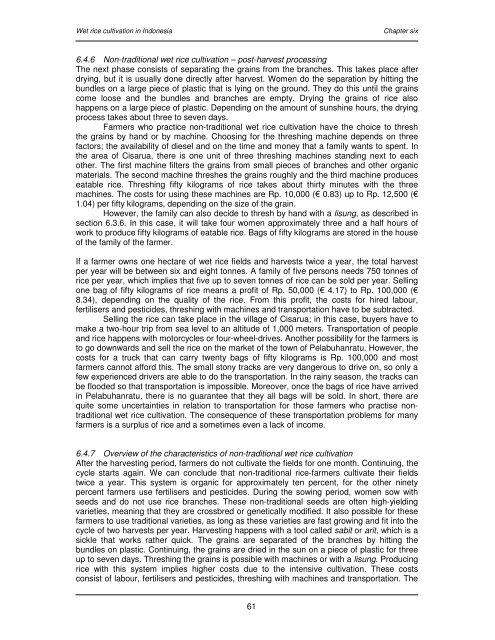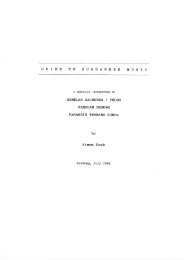Wet rice cultivation in Indonesia - Free EBooks Library
Wet rice cultivation in Indonesia - Free EBooks Library
Wet rice cultivation in Indonesia - Free EBooks Library
Create successful ePaper yourself
Turn your PDF publications into a flip-book with our unique Google optimized e-Paper software.
<strong>Wet</strong> <strong>rice</strong> <strong>cultivation</strong> <strong>in</strong> <strong>Indonesia</strong> Chapter six<br />
6.4.6 Non-traditional wet <strong>rice</strong> <strong>cultivation</strong> – post-harvest process<strong>in</strong>g<br />
The next phase consists of separat<strong>in</strong>g the gra<strong>in</strong>s from the branches. This takes place after<br />
dry<strong>in</strong>g, but it is usually done directly after harvest. Women do the separation by hitt<strong>in</strong>g the<br />
bundles on a large piece of plastic that is ly<strong>in</strong>g on the ground. They do this until the gra<strong>in</strong>s<br />
come loose and the bundles and branches are empty. Dry<strong>in</strong>g the gra<strong>in</strong>s of <strong>rice</strong> also<br />
happens on a large piece of plastic. Depend<strong>in</strong>g on the amount of sunsh<strong>in</strong>e hours, the dry<strong>in</strong>g<br />
process takes about three to seven days.<br />
Farmers who practice non-traditional wet <strong>rice</strong> <strong>cultivation</strong> have the choice to thresh<br />
the gra<strong>in</strong>s by hand or by mach<strong>in</strong>e. Choos<strong>in</strong>g for the thresh<strong>in</strong>g mach<strong>in</strong>e depends on three<br />
factors; the availability of diesel and on the time and money that a family wants to spent. In<br />
the area of Cisarua, there is one unit of three thresh<strong>in</strong>g mach<strong>in</strong>es stand<strong>in</strong>g next to each<br />
other. The first mach<strong>in</strong>e filters the gra<strong>in</strong>s from small pieces of branches and other organic<br />
materials. The second mach<strong>in</strong>e threshes the gra<strong>in</strong>s roughly and the third mach<strong>in</strong>e produces<br />
eatable <strong>rice</strong>. Thresh<strong>in</strong>g fifty kilograms of <strong>rice</strong> takes about thirty m<strong>in</strong>utes with the three<br />
mach<strong>in</strong>es. The costs for us<strong>in</strong>g these mach<strong>in</strong>es are Rp. 10,000 (€ 0.83) up to Rp. 12,500 (€<br />
1.04) per fifty kilograms, depend<strong>in</strong>g on the size of the gra<strong>in</strong>.<br />
However, the family can also decide to thresh by hand with a lisung, as described <strong>in</strong><br />
section 6.3.6. In this case, it will take four women approximately three and a half hours of<br />
work to produce fifty kilograms of eatable <strong>rice</strong>. Bags of fifty kilograms are stored <strong>in</strong> the house<br />
of the family of the farmer.<br />
If a farmer owns one hectare of wet <strong>rice</strong> fields and harvests twice a year, the total harvest<br />
per year will be between six and eight tonnes. A family of five persons needs 750 tonnes of<br />
<strong>rice</strong> per year, which implies that five up to seven tonnes of <strong>rice</strong> can be sold per year. Sell<strong>in</strong>g<br />
one bag of fifty kilograms of <strong>rice</strong> means a profit of Rp. 50,000 (€ 4.17) to Rp. 100,000 (€<br />
8.34), depend<strong>in</strong>g on the quality of the <strong>rice</strong>. From this profit, the costs for hired labour,<br />
fertilisers and pesticides, thresh<strong>in</strong>g with mach<strong>in</strong>es and transportation have to be subtracted.<br />
Sell<strong>in</strong>g the <strong>rice</strong> can take place <strong>in</strong> the village of Cisarua; <strong>in</strong> this case, buyers have to<br />
make a two-hour trip from sea level to an altitude of 1,000 meters. Transportation of people<br />
and <strong>rice</strong> happens with motorcycles or four-wheel-drives. Another possibility for the farmers is<br />
to go downwards and sell the <strong>rice</strong> on the market of the town of Pelabuhanratu. However, the<br />
costs for a truck that can carry twenty bags of fifty kilograms is Rp. 100,000 and most<br />
farmers cannot afford this. The small stony tracks are very dangerous to drive on, so only a<br />
few experienced drivers are able to do the transportation. In the ra<strong>in</strong>y season, the tracks can<br />
be flooded so that transportation is impossible. Moreover, once the bags of <strong>rice</strong> have arrived<br />
<strong>in</strong> Pelabuhanratu, there is no guarantee that they all bags will be sold. In short, there are<br />
quite some uncerta<strong>in</strong>ties <strong>in</strong> relation to transportation for those farmers who practise nontraditional<br />
wet <strong>rice</strong> <strong>cultivation</strong>. The consequence of these transportation problems for many<br />
farmers is a surplus of <strong>rice</strong> and a sometimes even a lack of <strong>in</strong>come.<br />
6.4.7 Overview of the characteristics of non-traditional wet <strong>rice</strong> <strong>cultivation</strong><br />
After the harvest<strong>in</strong>g period, farmers do not cultivate the fields for one month. Cont<strong>in</strong>u<strong>in</strong>g, the<br />
cycle starts aga<strong>in</strong>. We can conclude that non-traditional <strong>rice</strong>-farmers cultivate their fields<br />
twice a year. This system is organic for approximately ten percent, for the other n<strong>in</strong>ety<br />
percent farmers use fertilisers and pesticides. Dur<strong>in</strong>g the sow<strong>in</strong>g period, women sow with<br />
seeds and do not use <strong>rice</strong> branches. These non-traditional seeds are often high-yield<strong>in</strong>g<br />
varieties, mean<strong>in</strong>g that they are crossbred or genetically modified. It also possible for these<br />
farmers to use traditional varieties, as long as these varieties are fast grow<strong>in</strong>g and fit <strong>in</strong>to the<br />
cycle of two harvests per year. Harvest<strong>in</strong>g happens with a tool called sabit or arit, which is a<br />
sickle that works rather quick. The gra<strong>in</strong>s are separated of the branches by hitt<strong>in</strong>g the<br />
bundles on plastic. Cont<strong>in</strong>u<strong>in</strong>g, the gra<strong>in</strong>s are dried <strong>in</strong> the sun on a piece of plastic for three<br />
up to seven days. Thresh<strong>in</strong>g the gra<strong>in</strong>s is possible with mach<strong>in</strong>es or with a lisung. Produc<strong>in</strong>g<br />
<strong>rice</strong> with this system implies higher costs due to the <strong>in</strong>tensive <strong>cultivation</strong>. These costs<br />
consist of labour, fertilisers and pesticides, thresh<strong>in</strong>g with mach<strong>in</strong>es and transportation. The<br />
61








